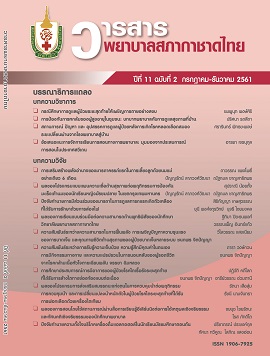Situations, Problems, and Barriers of Post-Stroke Care in the Transitional Period from Hospital to Home
Keywords:
post-stroke care, situations, problems, barriers, transitional periodAbstract
This article presents analytical writing from literature reviews and experiences in community research to reflect the current situations, problems, and barriers of post-stroke care. The article summarizes the main points of the contents and suggests solutions for post-stroke care. There are still weaknesses in post-stroke care and rehabilitation among family caregivers owing to inadequate knowledge, a lack of caregiver skills, and insufficient social support. In particular, post-stroke patients and their family caregivers need help and supports from the health care team during the transitional period from hospital to home. However, failure to provide support and delays in receiving appropriate support from the health care team have been reported. Therefore, the development of guidelines for post-stroke care is very important to establish clear guidelines and it should be integrated with a multidisciplinary team. The guidelines for post-stroke care should focus on an early recovery, competence building in family caregivers’ roles, and community health volunteers. Finally, stroke patients will receive proper and continuous care as soon as they are being discharged to home.
References
2. Hickey JV. The clinical practice of neurological and neurosurgical nursing. 6th ed. Philadelphia: Wolters Kluwer Health; 2009.
3. Scottish Intercollegiate Guidelines Network (SIGN). Management of patients with stroke: rehabilitation, prevention and management of complications, and discharge planning a national clinical guideline. Edinburgh: Scottish Intercollegiate Guidelines Network; 2010.
4. Good DC, Bettermann K, Reichwein RK. Stroke rehabilitation. Continuum (Minneap Minn) 2011;17(3):545–67.
5. Ross SY, Roberts S, Taggart H, Patronas C. Stroke transitions of care. Medsurg Nurs 2017;26(2):119-22.
6. Prasat Neurological Institute. Clinical practice guidelines for ischemic stroke [Internet]. 2007 [cited 2017 Mar 10]. Available from: https:// www.pni.go.th
7. Ratanakorn D, Keandoungchun J, Sittichanbuncha Y, Laothamatas J, Tegeler CH. Stroke fast track reduces time delay to neuroimaging and increases use of thrombolysis in an academic medical center in Thailand. J Neuroimaging 2012;22(1):53-7.
8. Suwanwela NC. Management of acute ischemic stroke. Bangkok: Chulalongkorn University; 2007. (in Thai)
9. Suwanwela NC, Eusattasak N, Phanthumchinda K, Piravej K, Locharoenkul C. Combination of acute stroke unit and short-term stroke ward with early supported discharge decreases mortality and complications after acute ischemic stroke. J Med Assoc Thai 2007;90(6):1089-96.
10. สถาบันประสาทวิทยา. แนวทางการฟื้นฟูสมรรถภาพผู้ป่วยโรคหลอดเลือดสมอง. กรุงเทพฯ: ธนาเพลส; 2559.
11. Sakunhongsophon S, Ananthachock S, Hosakun K. Selected factors, activities of daily living and complications in stroke survivors at home. J Nurs Educ 2011;4(2):36-52.
12. Kasornsunt P. Case study: stroke. Nurs J MPH. 2013;22(2):80-95. (in Thai)
13. กองการพยาบาลสาธารณสุข สำนักอนามัย กรุงเทพมหานคร. การดูแลผู้ป่วยโรคหลอดเลือดสมองที่บ้านสำหรับบุคลากรสาธารณสุข. กรุงเทพฯ: กระทรวงสาธารณสุข; 2554.
14. สถาบันประสาทวิทยา. แนวทางการพยาบาลผู้ป่วยโรคหลอดเลือดสมองสําหรับพยาบาลทั่วไป. กรุงเทพฯ: สถาบันประสาทวิทยา กรมการแพทย์ กระทรวงสาธารณสุข; 2550.
15. Paksee N, Sirapo-ngam Y, Monkong S, Leelacharas S. Effects of a transitional care program for stroke patients and family caregivers on caregiver’s preparessness, stress, adaptation, and satisfaction. Rama Nurs J 2016;22(1):65-80. (in Thai)
16. Chaiyawata P, Kulkantrakornb K. Effectiveness of home rehabilitation program for ischemic stroke upon disability and quality of life: a randomized controlled trial. Clin Neurol Neurosurg 2012;114(7):866–70.
17. Pitthayapong S, Thiangtam W, Powwattana A, Leelacharas S, Waters CM. A community based program for family caregivers for post stroke survivors in Thailand. Asian Nurs Res 2017;11(2):150-7.
18. Ruttawongsa A, Kongtaln O. Development of the community–based continuing care management guideline for stroke survivors of Kosumpisai hospital and it’s network [research]. Khon Kaen: Khon Kaen University; 2012.
19. Petchroung N, Priyatruk P, Thongkeang V. The study of continuing care for patients with cerebrovascular disease in primary care unit. J Royal Thai Army Nurs 2013;14(1):25-34. (in Thai)
20. Piyabundigul L. Exploring patient’s problems to improve quality of life after stroke in community. Journal of Nurses’ Association of Thailand, North-Eastern Division 2012;30(4):6-14. (in Thai)
21. Danzl MM. Developing the Rehabilitation Education for Caregivers and Patients (RECAP) model: application to physical therapy in stroke rehabilitation [dissertation]. College of Health Sciences. Kentucky: University of Kentucky; 2013.
22. Umarova RM, Nitschke K, Kaller CP, Kloppel S, Beume L, Mader I, et al. Predictors and signatures of recovery from neglect in acute stroke. Ann Neurol 2016;79(4):673-86.
23. Hadidi N, Treat-Jacobson DJ, Lindquist R. Poststroke depression and functional outcome: a critical review of literature. Heart Lung 2009;38(2):151-62.
24. Kneebone II, Lincoln NB. Psychological problems after stroke and their management: state of knowledge. Neurosci Med 2012;3:83-9.
25. Bakas T, Clark PC, Kelly-Hayes M, King RB, Lutz BJ, Miller EL. Evidence for stroke family caregiver and dyad interventions: a statement for healthcare professionals from The American Heart Association and American Stroke Association. Stroke 2014;45(9):2836-52.
26. Prasat Neurological Institute. The development of tertiary medical services and the higher for persons with stroke. Bangkok: Department of Medical Services Ministry of Public Health; 2009. (in Thai)
27. Winstein CJ, Stein J, Arena R, Bates B, Cherney LR, Cramer SC, et al. Guidelines for adult stroke rehabilitation and recovery: a guideline for healthcare professionals from the American Heart Association/American Stroke Association. Stroke 2016;47(6):e98-e169.
Downloads
Published
Issue
Section
License
เนื้อหาบทความหรือข้อคิดเห็นต่างๆ ในวารสารพยาบาลสภากาชาดไทยนี้ เป็นความคิดเห็นของผู้เขียนบทความ ไม่ใช่ความเห็นของกองบรรณาธิการ หรือสถาบันการพยาบาลศรีสวรินทิรา สภากาชาดไทย






